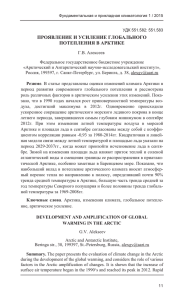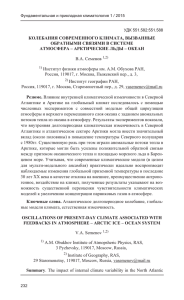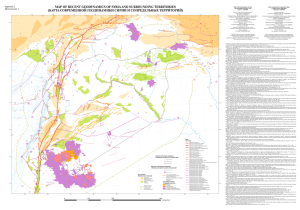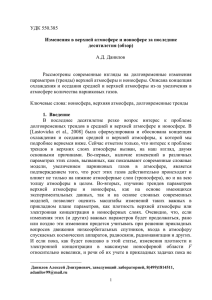изменения потоков нисходящей длинноволновой радиации и
реклама
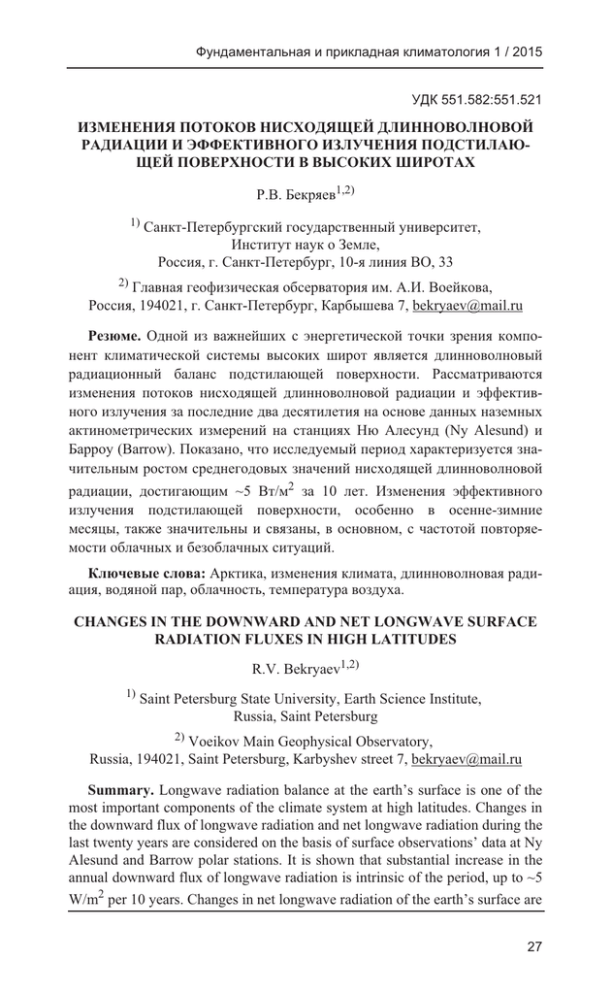
1 / 2015 E_' 551.582:551.521 >? @JQU J U J X YZZ >[ J \QU @ ] @ ^ @ .. 1,2) 1) - ! , > /$, , . -, 10- ), 33 2) &# $. .>. , , 194021, . -, +!( 7, [email protected] . ) # (% ' # $ $ $! !% ( ! "! * %. $ #$ %* " '&& # # !% #$!% $% #$ "% ; (Ny Alesund) (Barrow). #, $! %# #!$ $ !% # %* ", *$ ~5 /$2 # 10 . >#$ '&& # * %, -#$ $"!, #! #!, $, $ !% #!% ". : , #$ $, ", , , $ #%. CHANGES IN THE DOWNWARD AND NET LONGWAVE SURFACE RADIATION FLUXES IN HIGH LATITUDES R.V. Bekryaev1,2) 1) Saint Petersburg State University, Earth Science Institute, Russia, Saint Petersburg 2) Voeikov Main Geophysical Observatory, Russia, 194021, Saint Petersburg, Karbyshev street 7, [email protected] Summary. Longwave radiation balance at the earth’s surface is one of the most important components of the climate system at high latitudes. Changes in the downward flux of longwave radiation and net longwave radiation during the last twenty years are considered on the basis of surface observations’ data at Ny Alesund and Barrow polar stations. It is shown that substantial increase in the annual downward flux of longwave radiation is intrinsic of the period, up to ~5 W/m2 per 10 years. Changes in net longwave radiation of the earth’s surface are 27 1 / 2015 also substantial. They are associated mainly with the frequency of cloudy and clear sky conditions. Keywords: Arctic, climate change, longwave radiation, water vapor, cloudiness, air temperature. ! >#$ # % #$ (ULF – Upwelling Longwave Fluxes) # $&! (DLF – Downwelling Longwave Fluxes) *! * $% " !% (% $ ! !$ # &$ . %# $ %* " (Francis and Hunter, 2007). ] % % $ $! #$ #% (Bekryaev et al, 2010), #$ *$ * *! &*% $ $ (J)) (Serreze et al, 2007, Smedsrud et al, 2008, Comiso et al, 2008, Stroeve et al, 2012, Jeffries et al, 2013), ! !$ $ #!$ $ * (Rignot et al, 2008, Mote, 2008, Nghiem et al, 2012), $ % !% $$ #$. (Weston et al, 2007) #$!% "!% #$ ! #, % ", !% % + % (Alert (82030` N, 62020`W) Resolute Bay (74042`N, 94050`W)), #$ !% # DLF # (* 40 9 /$2. ># !% !% $ " # (Francis & Hunter, 2007) " ! DLF $"! ( % $ (", +, J!%, -, ` &). ( $ # DLF # !$ 6,9 /$2 # . ! ! #!, # $ H2O, $ #!$ (!$ #$, $ DLF !% (% #, , #$$ % &!. #$ (Francis & Hunter, 2007) #$ ! &$ $ DLF $ . # '&& #$ $& *. $ 60% ( 75 /$2) " &, $ # # #$ % %* " % " $&!, #! $ *$ (Kiehl and Trenberth, 1997). $$ ', # ! "! * %28 1 / 2015 . $ 2-3 # #$ $! #% # (Held, Soden, 2000). CO2, $ ( % !% #, $ # !% $& , % $ % $& " $ (Schneider et al, 2010, Bengtsson, 2010). $( $& $(, !* # $ #!$ $ #$ (, #!, $ #$, . $ $, , $, # $ #%. /$ !* $!, !$ $ +#-+, #$ #$ #" # %* " $! #% & (Bony et al, 2006). $! #% " j$, !#! %* ". C %* ", , * % #$ #%. *, , * " j$ #%, $ $, , % !! $ ! $$ $( % , $$ % (Held, Soden, 2000, Ramanathan, Inamdar, 2006, Sherwood et al, 2010b). Dai, 2006 !% #$!% ! !, # 1976-2004. #$ #$ !( 0,6% #. + !$ !$ #!% *% #$% #% # 1970-2008. ( ! ! (McCarthy et al, 2009), # ! # $&! $ (. , ! $& %# !!$ !$ %$ $$$$ ! $"! $$$$ $! %!. D % " #$ $ % #. * %, $ $(, !% (% #. "$ ! !#! %* '&&, $ # %* " (Ramanathan et al, 1989). $ ! # &$ '&&, * # # #$ &$ %* ". ) &$ %* " !% (% ! (, % ! 29 1 / 2015 $ "$ * , #$$ $! !( (Held, Soden, 2000, Sherwood et al, 2010a). )" & * % , !$ SHEBA (Surface Heat Budget of the Arctic), $ # 38 /$2 (Intrieri et al, 2002). +! ! & " * $( , –10 /$2. )* !!$ !$ %$ $$$$ $ $$$$ #$- . (Dong et al, 2010) $ #! " ! -!% $% #$ " 1998 $ 2008. ! #, ! ( % "!) $ $ (0,57 0,84), !$ $ (~ 0,8-0,9) #$ $( $ (0,8 0,57), $ # 0,76. # % $ # (# $ # ERA-Interim) ! $ (Walsh et al, 2009) $ !$ $! # 1999-2006. L "$ ( $ $ , #$ $$$ $$$ #. % (Chernokulsky and Mokhov, 2012, `, 2012) ( j$ !% #$!% , # (!% $!% # ! $! % * 600 (!. )" * !% "$ ) 0,70 ± 0,03. ", ! !$ #$!% , %# $$$$ - $$$$ &. $, !% (% , ( ( % "% #!$ $ !% , , $$ #$ (`, X%, 2010). [ ! " #$ $ # * % % "% # " '% #$ *$ $ !% (. ! " ! #$ " &$ %* ". J D " $ " * % $ $ "! $ % # 1993-2014. % "% ; , ", 78°55N 11°56E , , 71°18N 156°46W. D! ! ! Baseline Surface Radiation 30 1 / 2015 Network (BSRN), http://www.bsrn.awi.de. D " ! # 2010-2014 ! ! #! NOAA, ftp://aftp.cmdl.noaa.gov/data/ radiation/baseline/brw/. D! ", ! $% BSRN, !$ $$ #(, #$!% (Ohmura et al, 1998). , ( #$ %* " 1995 !( 10 /$2. >#$ %* %* " '% "% #$ $ ] (Pyrgeometer, Eppley). )$ "!$ %$ & $ #$ #%, #% $& . D 1997. " 3 $!, 1998. #$ $!$. ; " ; 1998. #$ * ! 5 $, 1999. $. )" !% % $&! #$ # ' # $&!, # !% $, http:// weather.uwyo.edu/upperair/. 0'! !+ "!)!+ 0 ')!$# / ! ""/ D $! #$ $! # " Ny Alesund # 1993-2013. " $! # 19942014. !, ! !$ $"$ !$, # * " $!% (. 1a), * !$ $ $. J! ! !% # DLF #$! 5% #$ ! ; 5,3 /$2/10, " 4,8 /$2/10. / 20 #$ * " 10 /$2. % !% # ( , %* # !( $! #%), ' ! ! * # $ $ $. $, ! (Sorteberg et al, 2007) " DLF ()) # 19581998. !$ # ERA-40 NCEP/NCAR * $(. D ERA-40 DLF 1,22 /$2/10, ULF 1,00 /$2/ 10. D NCEP/NCAR * " 0,73 1,34 /$2/10. $ # #! ) ! ! (Wang et al, 2012) !% !% (AVHRR APP-x) # 19822004. , !% # DLF * % $ 1,23 /$2/10, ULF 1,57 31 1 / 2015 /$2/10. ) (% " !% !% % #, , !$ $ !% !% !% #, $ " !% ( (Bekryaev et al, 2010) *$ $ DLF. 1 – 1 – b 32 1 / 2015 1 – c 1 – 8 & " & . ) % & " \ " ] ( ), L # ( ), b) " " & " " ] ( ), L # ( ). c) " " %>[ ( ) & " " ] ( ), L # ( ). ! " !% DLF # #$, !$ (Francis and Hunter, 2007 Weston et al, 2007). ) ( %* # $$!% "% $"!, $ !% %, #%! & ; (. 1b). F $ ! # *$ * *! $ , -#$ ! # $&. $, ! DLF, ! !% $" , ( $ #$!$. F, " ! 95% #$ , " ; – . ), $!% # $ #$ #! $"! (. 1) # !% ! #$ #$ %* ". 33 1 / 2015 2 – 2 – b 2a – 8 < (PW) " . 8 " ] . % " " ", PW = 9,9 exp(0,052t0), R2 = 0,94 2b – L& " " < . % " ] . % " ", DLF = 79,11ln(PW) + 103,5, R2 = 0,92 34 1 / 2015 *! DLF *$ $ $ , , $ $&. ; . 2a #$ (PW – Precipitable Water) % #$ 8 000 $ $! #$ #% " . $! 1K $&$ $ 5,2%, 1 wPW PW wT 0.052 #$ $! #$ #% # "$, !$ % (Raval, Ramanathan, 1989, Stephens, 1990, Duvel, Breon, 1991, Slingo et al, 2000). >#$ $& ( # 1973-2006., $ (Durre et al, 2009), $ #$! ! , * 0,4 /$2/10. " #$ (O’Gorman & Muller, 2010), ($ # !% '$ $$ CMIP3, $& /$ $! #$ #% 7,3% +-1. "& $ # ", * # # &$! +#-+. /$ DLF "$ #!, ! Zhang et al, 2001 " !$ "% X & (). " DLF &$ PW $ !, $* # $ 92% . D ! " % # !% # &! $", $ $ %. ; 3 ! $! $$! %* " '&& # "% ; . ' $" % "% , "! % !$ $$. +$ , ( #$ %* " " ; $ . ) ! %# $!$ $, , , , * !$ &$ &$ DLF. + , " #!$ $ 100% . !% (% . % '&& # $ ( #, DLF ( ULF. >, , $ ! $ - 35 1 / 2015 ", " '&& # $ # &$, !$ #$: , 29,7 /$2, +) 24 /$2, ; , 30,9 /$2, +) 24 /$2. 3a 3b 3c 3d 3 – L & " (a, c) (b, d), 5/2, " L # (a, b) ] (c, d). $ – . $ '&& # $, , Stamler et al, 2011 # $!% '$ SHEBA. D #$ ! !! $! '&& #, * #$ 0 /$2 40 /$2. ;( #!, ! . 3, $ ( $ 36 1 / 2015 ( #$% – $ # # 0 10 /$2, # 40 60 /$2. ) $ “!%” " (NetLF 0) (Stamler et al, 2011) # $ 2,5 # $(, $ $ «%!%» " (NetLF 40). ;, ( " (. 3) #! $$ $ " NetLF #$ , % $ «» $ #! # «%» $. Stamler et al, 2011 #, !! $! $ $ , * *$ !$ $ $!% !% % &!. > $, % "% # " "!$ #$ '&& #. ; " , %* " !( %*, (, $ " ; . $ !% (% $ $% % (Curry et al, 1996). $ '$ SHEBA $ 70% , !* 0,95 , 20% ! 0,05 (Chen et al, 2006). /$ ! *, $ $. >, $ U – # &" $$$$, *$ ( , & $! $"! , # $ , (Clark & Walsh, 2010), $ ! "! , , !( % $. D " &$ " $! $ #$ !!% $$ $ DLF NetLF , # $ . F # $*% !%, ! " #$ $ " * # J) (Stroeve et al, 2012). ; 4 ! * '$ $ !! $$! %* " '&& #. ), DLF NetLF $$ $% $ # # #$. D " #$ DLF NetLF # #!, !$ #$, #!$ $($ '&& # ( ~8-9/$2) 2004-2008. $ DLF ' ! ( ~ 10 /$2). F , , *!$ $ 2004-2008. (2009-2014) " %# #*$ &!$ #$ %* " '&& #. ; " ; #$ ! #! #!$ $ DLF, - 37 1 / 2015 ($ # 20 33 /$2. ]&& # $( # $ 8 /$2. $, #$ '&& # ! #!, !$ #$, $ $ , *% $ $$$ NetLF, ( . ; " ; $ % 2009-2013. 1994-1998. $ 1,5 #. ; " $ «!%» " 2004-2008. * !( &! #. F$ #$, $ ! " ; . ), #$ '&& # ' " * ($ 4 #) #$$ %* ", , ! % # DLF ; # 1994-2013. # $ $! #% *$ $ &. 4.1a 4.1c 38 4.1b 4.1d 1 / 2015 4.2a 4.2b 4.2c 4.2d 4.3a 4.3b 4 – L & " (4.1, 4.3) (4.2, 4.4). f . L #, (4.1, 4.2), a) 1994-1998, b) 1999-2003, c) 2004-2008, d) 2009-2013. ] , (4.3, 4.4), a) 1994-1997, b) 1998-2003, c) 2004-2008, d) 2009-2014. 39 1 / 2015 4.3c 4.3d 4.4a 4.4b 4.4c 4.4d 4 – L & " (4.1, 4.3) (4.2, 4.4). f . L #, (4.1, 4.2), a) 1994-1998, b) 1999-2003, c) 2004-2008, d) 2009-2013. ] , (4.3, 4.4), a) 1994-1997, b) 1998-2003, c) 2004-2008, d) 2009-2014. 40 1 / 2015 D ( ! ! ! " ! ! "! &, Cloud Radiative Forcing (CRF). F & " # $ $!$ DLF "$!$ !$ %*$ #$ DLFCS, CRF = DLF-DLFCS. D " DLFCS # #! $#" (X(, 1980, Makshtas et al, 1998, Maykut and Church, 1973, Konig-Langlo and Augstein, 1994, Brutsaert, 1975, Prata, 1996). )" % % # DLFCS * , 127 /$2 # &$! 171 /$2 $ $#" X(. $ $$ , J-( " 157, 135 168 /$2. )" $ % ! # " & $, #$ ! $#" " !% CRF # #. ; " ; ! "! & # $! $ 10 /$2. ` CRF "$ (Shupe, Intrieri, 2004) #$$ % 0,3 0,8 $-2 %-1 $ # 0,65 $-2%-1. F # ", Chen et al, 2006 !$ SHEBA $ !% * 0,1 0,9 $-2%-1 $ # 0,68 $-2%-1. `! '$! $$ IPCC AR4 % & # #$!! " #$ DLF #$ ; 0,96 ± 1,1 $-2%-1 #$ 0,45 ± 0,85 $-2%-1 $ (Sorteberg et al, 2007). $ " #$ & # "$ #$ '&& # * "% ( 2004-2008) ; ( 2004-2013) $ 1 . 0/2! "/*'' ! " $ CRM (Column Radiative Model) #$ % $ $ CMIP3 & $! #% # 1900-1949 2150-2199. (Boe et al, 2009) ! '&& # * % # . / Boe et al, 2009 % #$ # (Screen & Simmonds, 2010), $ *% #$ $ (Sorteberg et al, 2007). (Screen & Simmonds, 2010), # ERA-Interim (Simmons et al, 2006) #, 1989. 2009. 41 1 / 2015 %# "!$ $ NetLF. #! # $ 20-21. " $!$ $$ IPCC AR4 "$ A2 $ $( '&& # !% (% $ (Sorteberg et al, 2007). )! $ $!% #$ # ( # # 2080-2100 $ # # 1980-2000) DLF 30,1 /$2, ULF 27,1 /$2, '&& # $( 3,0 /$2. %* % " $( '$ 10,7 /$2, j $ , # $( % " * , 13,2 /$2. F$ #$, "! % !% (% ( $ $ $ ! # 100 $ 5,5 /$2. #! !% #$ * , !% !. Wang and Key 2003, 2012 !% !% # #$ 60°.(. # 1982-1999. $! ! &" ! #, – $ #, 3%/10 1,5%/10 , #! $ " ' . ) " , #$ ( $ $ " $( , #$ -5%/10 , $ ! " % $ . C$( J) #$ $"! # 1982. 2000. ! #& (Liu et al, 2007), $$ !% !% # #! $& #. ! $( $ * , % + " $. # !#! ( $, $ # $ $ ! (! (Bengtson et al, 2011, Zhang et al, 2013). (Eastman and Warren, 2010) # # ( # 60°-90°.(. # ! , %!* 1971-2007. )* #$ ! #$!, ! ! # . "$ # $$! % # * . ! $ " #$ '&& # "% ; # # ! "% #$ $ . Z " ; # 20 '&& #- 42 1 / 2015 $( $ 8 /$2, $! *!% #$ NetLF &. )" #$ %* " !$. L # $ !% " % $" #$!, #! #$! !, %( * #$ % . $, %* " #$ ! , -$$, *$ &$ * * *! $ (Kapsh et al, 2013, Kapsh et al, 2014). !$ &$ * !% $ " #$ DLF NetLF " ; . #$ %* " # 20 # $ 4 # ( #$ NetLF, #$ '&& #, , ! #! $ $ !% " (. 4) $ #, DLF ! $&. *% #$% $ !% (, , $ . $ ! * $ J), (Vavrus et al, 2011) $!% 21 $ CCSM3 (Community Climate System Model) #, $ * $ ( $ $ . # !% # # " " * , J) # $ ( 7 10%, ) $$ $( * 5-7% (Palm et al, 2010). F #! ! ! #, $ DLF * &*% . ) $ , $ # $ $ $ $ ! %, * ! '$ 82%, , , % **% , 100% # 12-15 (Palm et al, 2010). )" $ * %, ! !% $% "% ; , !% % %* " # . , ! !% # DLF - 43 1 / 2015 " ; 5,3 /$2/10, $! 4,8 /$2/10. -#$ #$ DLF NetLF !! . , DLF , # 2009-2013 !, " ; 236,5 /$2, 33 /$2 ( !% " # 1994-1998. /$ () NetLF % " # $ # %# $ !!$ $$. $ #$ '&&$ # # 45-60 /$2, #!$ ($!$) $. $ $ NetLF (0-10 /$2) $ ! # !$ $ ( . D " ; #& * $( '&& #, ( $ 8 /$2. D " # * NetLF, $( $ $ 1998 2008 ., $ ! #$ &!$ #$. $, #$ NetLF " ; $ 4 # $( #$ DLF. !$ #$ " #$ " & 3-4 # "$ #$ DLF. ] , -$$, * &$ %* " . !'"'/" X( X.. 1980. C &$ % " $ !. –J., $#, 211. ` .., X% >.>. 2010. ! # % # #!$ !$ #$!$ $. > /$ # $, 3, .12-29. ` .. 2012. +$ % % (% !$ #$!$ $ !$ #. -#$ &#, 21, . 73-78. Bekryaev R.V., Polyakov I.V., and Alekseev V.A. 2010. Role of Polar Amplification in Long-Term Surface Air Temperature Variations and Modern Arctic Warming. J. Climate, Vol.23, pp. 3888-3906. Bengtsson L. 2010. The global atmospheric water cycle. Environ.Res.Lett., 5, 025001 (8pp), doi:10.1088/1748-9326/5/2/025001. Bengtsson L., Hodges K.I., Koumoutsaris S., Zahn M., and Keenlyside N. 2011. The changing atmospheric water cycle in Polar Regions in a warmer climate. Tellus, vol. 63A, pp. 907-920. 44 1 / 2015 Boe J., Hall A., and Qu X. 2009. Current GCM’s unrealistic negative feedback in the Arctic. J.Climate, vol.22, pp. 4682-4695. Bony S., Colman R., Kattsov V.M., Allan R.P., Bretherton C.S., Dufresne J.-L., Hall A., Hallegatte S., Holland M.M., Ingram W., Randall D.A., Soden D.J., Tselioudis G., and Webb M.J. 2006. How well do we understand and evaluate climate change feedback processes, J. Climate, 19, pp. 3445-3482, doi:10.1175/JCLI3819.1. Brutsaert W. 1975. On a derivable formula for long-wave radiation from clear skies. Water Resources Research, Vol. 11, 5, pp. 742– 744. Chen Y., Aires F., Francis J.A., and Miller J.R. 2006. Observed relationships between Arctic longwave cloud forcing and cloud parameters using a neural network. J.Climate, vol.19, pp. 4087-4104. Chernokulsky A. and Mokhov I.I. 2012. Climatology of Total Cloudiness in the Arctic: An Intercomparison of Observations and Reanalyses. Advances in Meteorology, vol. 2012, Article ID 542093, 15 pages, doi:10.1155/2012/542093. Clark J.V., and Walsh J.E. 2010. Observed and reanalysis cloud fraction. J.Geophys.Res., 115, D23121, doi:10.1029/2009JD013235. Comiso J.C., Parkinson C.L., Gersten R., and Stock L. 2008. Accelerated decline in the Arctic sea ice cover. Geophys.Res.Lett., vol.35, L01703, doi:10.1029/2007GL031972 Curry J.A., Rossow W.B., Randall D., Schramm J.L. 1996. Overview of Arctic cloud and radiation characteristics. J.Climate, vol.9, pp.1731-1764. Dai A. 2006. Recent climatology, variability, and trends in global surface humidity. J.Climate, vol.19, pp. 3589-3606. Dong X., Xi B., Crosby K., Long C.N., Stone R.S., and Shupe M.D. 2010. A 10 years climatology of Arctic cloud fraction and radiative forcing at Barrow, Alaska. J.Geophys.Res., 115, D17212, doi:10.1029/2009JD013489. Durre I., Williams C.N. (Jr.), Yin X., and Vose R.S. 2009. Radiosonde-based trends in precipitable water over the Northern Hemisphere: An update. J.Geophys.Res., vol. 114, D05112, 8 pp., doi:10.1029/2008JD010989. Duvel J.Ph., and Breon F.M.. 1991. The clear-sky greenhouse effect sensitivity to a sea surface temperature change. J.Climate, vol.4, 11621169. Eastman R., and Warren S.G. 2010. Interannual variations of Arctic cloud types in relation to sea ice. J.Climate, vol.23, pp. 4216-4232. Francis, J.A., and Hunter E. 2007. Changes in fabric of the Arctic’s greenhouse blanket. Environ. Res. Lett., vol.2, 45011 (6pp), doi:10.1088/1748-9326/2/4/045011. 45 1 / 2015 Held I.M., and Soden B.J. 2000. Water vapor feedback and global warming. Annu.Rev.Energy Environ., vol.25, pp. 441-475. Intrieri J.M., Fairall C.W., Shupe M.D., Persson P.O.G., Andreas E.L., Guest P.S., and Moritz R.E. 2002. An annual cycle of Arctic surface cloud forcing at SHEBA. J. Geophys. Res., vol.107, C10, 8039, doi:10.1029/2000JC000439. Jeffries M.O. Overland J.E., and Perovich D.K. 2013. The Arctic shifts to a new normal. Physics Today, 66(10), pp. 35-40, doi: 10.1063/PT.3.2147. Kapsch M.L., Graversen R.G., Tjernstrom M. 2013. Springtime atmospheric energy transport and the control of Arctic summer sea ice extent. Nature Climate Change, 3(8), pp. 744-748. Kapsch, M.-L., Graversen R.G., Economou T., and Tjernstrom M. 2014. The importance of spring atmospheric conditions for predictions of the Arctic summer sea ice extent, Geophys. Res. Lett., 41, pp. 52885296, doi:10.1002/2014GL060826. Kiehl J.T. and Trenberth K.E. 1997. Earth’s annual global mean energy budget. Bulletin of the American Meteorological Society, vol. 78, No. 2, pp. 197-208. Konig-Langlo G., and Augstein E. 1994. Parameterization of the downward long-wave radiation at the Earth’s surface in polar regions. Meteorol. Zeitschrift, N.F. 3, H.6, 343-347. Liu Y., Key J.R., Francis J.A., and Wang X. 2007. Possible causes of decreasing cloud cover in the Arctic winter, 1982-2000. Geophys.Res.Lett., 34, L14705, doi:10.1029/2007GL030042. McCarthy M.P., Thorne P.W., and Titchner H.A. 2009. An analysis of tropospheric humidity trends from radiosondes. J.Climate, vol.22, pp. 5820-5838. Makshtas A.P., Andreas E.L., Svyashchennikov P.N., and Timachev V.F. 1998. Accounting for clouds in sea ice models. CRREL Report 98-9, p. 30. Maykut G.A., and Church P.E. 1973. Radiation Climate of Barrow, Alaska, 1962-66. J. Appl. Meteorol., vol.12, pp. 620-628. Mote T.L. 2008. Greenland surface melt trends 1973-2007: Evidence of a large increase in 2007. Geophys.Res.Let., vol. 34, L22507, doi:10.1029/2007GL031976. Nghiem S.V., Hall D.K., Mote T.L., Tedesco M., Albert M.R., Keegan K., Shuman C.A., DiGirolamo N.E. and Neumann G. 2012. The extreme melt across the Greenland ice sheet in 2012. Geophys. Res. Lett., Volume 39, Issue 20, doi:10.1029/2012GL053611. O’Gorman P.A. and Muller C.J. 2010. How closely do changes in surface and column water vapor follow Clausius-Clapeyron scaling in climate change simulations? Environ.Res.Lett., vol. 5. 46 1 / 2015 Ohmura A., Dutton E.G., Forgan B., Fröhlich C., Gilgen H., Hegner H., Heimo A., König-Langlo G., McArthur B., Müller G., Philipona R., Pinker R., Whitlock C.H., Dehne K., and Wild M. 1998. Baseline Surface Radiation Network (BSRN/WCRP): New Precision Radiometry for Climate Research. Bull. Amer. Meteor. Soc., vol. 79, No. 10, pp. 2115-2136. Palm S.P., Strey S.T., Spinhirne J., and Markus T. 2010. Influence of Arctic sea ice extent on polar cloud fraction and vertical structure and implications for regional climate. J.Geophys.Res., 115, D21209, doi:10.1029/2010JD013900. Prata A.J. 1996. A new long-wave formula for estimating downward clear-sky radiation at the surface. Q.J.R.Meteorol.Soc., vol.112, pp.1127-1151. Ramanathan V., Cess R.D., Harrison E.F., Minnis P., Barkstrom B.R., Ahmad E., and Hartmann D. 1989. Cloud-Radiative Forcing and Climate: Results from the Earth Radiation Budget Experiment. Science, New Series, vol. 243, No. 4887. (Jan. 6, 1989), pp. 57-63. Ramanathan V., and Inamdar A. 2006. The radiative forcing due to clouds and water vapor, in Frontiers of Climate Modeling, eds. J.T.Kiehl and V.Ramanathan, pp. 119-151. Raval A., Ramanathan V. 1989. Observational determination of the greenhouse effect. Nature, vol. 342, pp. 758-761. Rignot E., Box J.E., Burgess E., and Hanna E. 2008. Mass balance of the Greenland ice sheet from 1958 to 2007. Geophys.Res.Let., vol. 35, L20502, 2008, doi:10.1029/2008GL035417. Schneider T., O’Gorman P.A., and Levine X.J. 2010. Water vapor and the dynamics of climate changes. Rev. Geophys., 48, RG3001, doi:10.1029/2009RG000302. Screen J.A. and Simmonds I. 2010. Increasing fall-winter energy loss from the Arctic Ocean and its role in Arctic temperature amplification. Geophys.Res.Lett., 37, L16707, doi:10.1029/2010GL044136. Serreze M.C., Holland M.M., Stroeve J. 2007. Perspectives on the Arctic’s shrinking sea-ice cover. Science, vol.315, pp.1533-1536, doi:10.1126/science.1139426. Sherwood S.C., Ingram W., Tsushima Y., Satoh M., Roberts M., Vidale P.L., and O’Gorman P.A. 2010a. Relative humidity changes in a warmer climate. J.Geophys.Res., 115, D09104, doi:10.1029/ 2009JD012585. Sherwood S.C., Roca R., Weckwerth T.M., and Andronova N.G. 2010b. Tropospheric water vapor, convection and climate. Rev. Geophys., 48, RG 2001, doi:10.1029/2009RG000301. Shupe M.D. Intrieri J.M. 2004. Cloud radiative forcing of the Arctic surface: The influence of cloud properties, surface albedo, and solar zenith angle. J.Climate, vol. 17, pp. 616-628. 47 1 / 2015 Simmons A., Uppala S., Dee D., and Kobayashi S. 2006. ERAInterim: New ECMWF reanalysis products from 1989 onwards. Newsletter 110, 2006/07, ECMWF, 11 pp. Slingo A. Pamment J.A., Allan R.P., and Wilson P.S. 2000. Water vapor feedback in the ECMWF Reanalysis and Hadley Centre Climate Model. J.Climate, vol.13, pp. 3080-3098. Smedsrud L.H., Sorteberg A., and Kloster K. 2008. Recent and future changes of the Arctic sea-ice cover. Geophys.Res.Lett., Vol.35, L20503, doi:10.1029/2008GL034813. Sorteberg A., Kattsov V., Walsh J.E., Pavlova T. 2007. The Arctic surface energy budget as simulated with the IPCC AR4 AOGCMs. Clim. Dyn., 29, pp. 131-156, doi:10.1007/s00382-006-0222-9. Stramler K., Del Genio A.D., Rossow W.B. 2011. Synoptically driven Arctic winter states. J.Climate, vol. 24, pp. 1747-1762. Stephens G.L. 1990. On the relationship between water vapor over the oceans and sea surface temperature. J.Climate, vol. 3, pp. 634-645. Stroeve J.C., Serreze M.C., Holland M.M., Kay J.E., Malanik J., Barrett A.P. 2012. The Arctic’s rapidly shrinking sea ice cover: a research synthesis. Climatic Change, vol. 110, pp. 1005-1027, doi:10.1007/s10584-011-0101-1. Vavrus S., Holland M.M., Bailey D.A. 2011. Changes in Arctic clouds during intervals of rapid sea ice loss. Clim. Dyn., vol.36, 7-8, pp. 1475-1489, doi:10.1007/s00382-010-0816-0. Walsh J.E., Chapman W.L. and Portis D.H. 2009. Arctic cloud fraction and radiative fluxes in atmospheric reanalysis. J.Climate, vol.22, pp. 2316-2334. Wang X.J. and Key J.R. 2003. Recent trends in Arctic surface, cloud, and radiation properties from space. Science, 299, pp. 1725-1728. Wang X., Key J., Liu Y., Fowler C., Maslanik J., and Tschudi M. 2012. Arctic climate variability and trends from satellite observations. Advances in Meteorology, vol. 2012, 22 pages, doi:10.1155/2012/ 505613 Weston S.T., Bailey W.G., McArthur L.J.B., and Hertzman O. 2007. Interannual solar and net radiation trends in the Canadian Arctic. J. Geophys. Res., 112, D10105, doi:10.1029/2006JD008000. Zhang T., Stamnes K., Bowling S.A. 2001. Impact of the Atmospheric Thickness on the Atmospheric Downwelling Longwave Radiation and Snowmelt under Clear-Sky Conditions in the Arctic and Subarctic. J. Climate, 14, pp. 920-939. Zhang X., He J., Zhang J., Polyakov I., Gerdes R., Inoue J., Wu P. 2013. Enhanced poleward moisture transport and amplified northern high-latitude wetting trend. Nature Climate Change, vol.3, pp. 47-51, doi:10.1038/nclimate1631. 48
